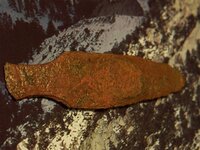history hunter
Bronze Member
- Apr 12, 2007
- 2,043
- 558
- Detector(s) used
- Nox 800 AT Max, Mine lab se pro/ Teknetics 7500 / teknetics 8000 / fisher m-scope (aquanut) 1280x/2ea compass relic magnum 6 /compass yukon 77b (professional) /compass yukon 71b
Well, I promised to post this one a year ago, before my comp. went out. I found this in Wisconsin about 1980 or so,by a lake. It was down about 12"+ and had a long oval shaped deposit,( which I removed). You can still see the outline of the deposit on the side of artifact. My high school teacher,(that was teaching us about artifacts), didn't even want to see it at the time. If anybody can tell me more about it, I would appreciate it. Thanks for looking. HH


Amazon Forum Fav 👍
Attachments
Upvote
0






